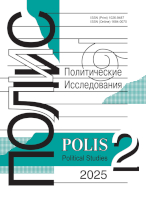Social Cleavages and Political Divides in a Theoretical Perspective:
Criteria for Assessment and Classification
Semenenko I.S.,
Primakov National Research Institute of World Economy and International Relations, Russian Academy of Sciences, Moscow, Russia, semenenko@imemo.ru
elibrary_id: 251670 | ORCID: 0000-0003-2529-9283 |
Lapkin V.V.,
Primakov National Research Institute of World Economy and International Relations, Russian Academy of Sciences, Moscow, Russia, vvlh@politstudies.ru
elibrary_id: 43429 | ORCID: 0000-0002-0775-2630 | RESEARCHER_ID: AAB-9386-2021
Pantin V.I.,
Primakov National Research Institute of World Economy and International Relations, Russian Academy of Sciences, Moscow, Russia, v.pantin@mail.ru
elibrary_id: 74145 | ORCID: 0000-0002-4218-4579 | RESEARCHER_ID: K-5736-2017
DOI: 10.17976/jpps/2021.05.05
Semenenko I.S., Lapkin V.V., Pantin V.I. Social Cleavages and Political Divides in a Theoretical Perspective: Criteria for Assessment and Classification. – Polis. Political Studies. 2021. No. 5. https://doi.org/10.17976/jpps/2021.05.05
Social cleavages and their political projections are key systemic elements in the evolutionary transformations of modern societies. Cleavage theory seeks to reflect the ambiguous and dynamic realities of contemporary divisions, but concepts and notions describing them often remain unclear. An overview of the mainstream theoretical and methodological approaches to assessing social and political divisions in contemporary societies indicates three key analytical standpoints: a) classical theory of social cleavages and their political projections (following Stein Rokkan and Seymour Martin Lipset); b) the politicization of new social divisions and of their potential transformation into competitive resources for promoting political projects; and c) political divides as drivers of social development. A correlation of these approaches can contribute to promoting a complex methodology of assessing political transformations in a rapidly changing contemporary world order. Economic and social inequality, cultural divides, and contentious politics are important indicators of growing divisions, alongside an ardent public discussion and a consistent research agenda on cultural and socio-political polarization. The authors consider institutionalized political divisions between identity groups (in the logic of Arend Lipjhart) as one of the possible characteristics (but not the only one) of divided societies, and argue for a wider approach to this concept. Growing cleavages of different natures are integral parts of contemporary social dynamics, but not all are politically relevant: politicizing cleavages is an inherent characteristic of “divided societies”, and criteria for their assessment are proposed. These criteria are applicable in the framework of both territorially localized (the nation state) and extraterritorial (non-state) communities. A cognitive map of cleavages and their political projections depicts the current state of the research field and offers insights for updating the research agenda.
References
Bartolini S., Mair P. 1990. Identity, Competition, and Electoral Availability: The Stability of European Electorates, 1885-1985. Cambridge: Cambridge University Press. 363 p.
Bartolini S. 2005. La formation des clivages. – Revue International de Politique Comparée. Vol. 12. No. 1. P. 9-34.
Bartolini S. 2011. Cleavages, Social and Political. – International Encyclopedia of Political Science. Ed. by B. Badie, D. Berg-Schlosser, L. Morlino Thousand Oaks: Sage. P. 276-282. https://doi.org/10.4135/9781412994163
Bogaards M. 2019. Consociationalism and Centripetalism: Friends or Foes? – Swiss Political Science Review. Vol. 25. No. 4. P. 519-537.
Bornschier S. 2009. Cleavage Politics in Old and New Democracies. – Living Reviews in Democracy. October. URL: http://www.livingreviews.org/lrd-2009-6
Collier D., Hidalgo F.D. and Maciuceanu A.O. 2006. Essentially Contested Concepts: Debates and Applications. – Journal of Political Ideologies. Vol. 11. No. 3. P. 211-246. https://doi.org/10.1080/13569310600923782
Deegan-Krause K. 2006. New Dimensions of Political Cleavage. – Oxford Handbook of Political Science. Ed. by R.J. Dalton, H.-D. Klingemann. Oxford-New York: Oxford University Press. P. 538-556. https://doi.org/10.1093/oxfordhb/9780199270125.003.0028
Grande E., Kriesi H. 2012. The Transformative Power of Globalization and the Structure of Political Conflict in Western Europe. – H. Kriesi, E. Grande, M. Dolezal, M. Helbling, D. Höglinger, S. Hutter, et al. Political Conflict in Western Europe. Cambridge: Cambridge University Press. P. 3-35. https://doi.org/10.1017/CBO9781139169219.003
Guelke A. 2012. Politics in Deeply Divided Societies. Cambridge MA: Polity. 240 p.
Guide on Measuring Human Capital. 2016. New York, Geneva: United Nations. 146 p.
Hooghe L., Marks G. 2018. Cleavage Theory Meets Europe’s Crises: Lipset, Rokkan, And the Transnational Cleavage. – Journal of European Public Policy. Vol. 25. No. 1. P. 109-135.
Horowitz D. 1985. Ethnic Groups in Conflict. Berkeley CA: University of California Press.
Inglehart R. 1990. Culture Shift in Advanced Industrial Society. Princeton, NJ: Princeton University Press. 504 p.
Inglehart R., Welzel Ch. 2005. Modernization, Cultural Change, and Democracy: The Human Development Sequence. Cambridge: Cambridge University Press. 333 p.
Isaaсs R., Polese A. 2016. Nation-Building and Identity in the Post-Soviet Space. New Tools and Approaches. London, New York: Routledge. 272 p.
Kriesi H. 1998. The Transformation of Cleavage Politics: The 1997 Stein Rokkan Lecture. – European Journal of Political Research. Vol. 33. No. 2. P. 165-185.
Lemay-Hebert N. 2009. State-building without Nation-building? Legitimacy, State Failure, and the Limits of Institutionalist Approach. – Journal of Intervention and Statebuilding. Vol. 3. No. 1. P. 21-45.
Lijphart A. 1968. The Politics of Accommodation: Pluralism and Democracy in the Netherlands. Berkley and Los Angeles: University of California Press. 222 p.
Lijphart A. 1977. Democracy in Plural Societies: A Comparative Exploration. New Haven: Yale University Press. 248 р.
Lipset S.M. 1960. Political Man: The Social Basis of Politics. Garden City N.Y.: Doubleday. 432 p.
Lipset S.M., Rokkan S. 1967. Cleavage Structures, Party Systems and Voter Alignments: An Introduction. – Party Systems and Voter Alignments: Cross-national Perspectives. Ed. by S.M. Lipset, S. Rokkan. New York: Free Press. P. 1-64.
Lybeck J.A. 1985. Is the Lipset-Rokkan Hypothesis Testable? – Scandinavian Political Studies. Vol. 8. No. 1-2. P. 105-113.
Mudde C., Kaltwasser C.R. 2017. Populism: A Very Short Introduction. Oxford: Oxford University Press. 136 p.
Norris P., Inglehart R. 2019. Cultural Backlash: Trump, Brexit and Authoritarian Populism. New York: Cambridge University Press. 564 p.
O’Flynn I. 2010. Democratic Theory and Practice in Deeply Divided Societies. – Representation. Vol. 46. No. 3. P. 281-293. https://doi.org/10.1080/00344893.2010.499696
Rokkan S. 1967. Geography, Religion and Social Class: Cross Cutting Cleavages across Norwegian Politics. – Party Systems and Voter Alignments: Cross-national Perspectives. Ed. by S.M. Lipset, S. Rokkan. New York: Free Press. P. 379-386.
Rokkan S. 1973. Cities, States, and Nations: A Dimensional Model for the Study of Contrasts in Development. – Building States and Nations: Methods and Data Resources. Ed. by S.N. Eisenstadt, S. Rokkan. Vol. I. Beverly Hills, CA: Sage Publications. P. 73-97.
Rydgren J. 2017. Radical Right-Wing Parties in Europe. What’s Populism got to do with it? – Journal of Language and Politics. No. 4. P. 485-496.
Sartori G. 1976. Parties and Party Systems. A Framework for Analysis. Cambridge: Cambridge University Press. 383 p.
Seiler D.-L. 2009. Clivages et familles politiques en Europe. Bruxelles: Ed. de l’Université de Bruxelles. 322 p.
State Formation, Nation-Building, and Mass Politics in Europe. The Theory of Stein Rokkan. 1999. Ed. by P. Flora, S. Kuhle, D. Urwin. Oxford: Oxford University Press. 422 p.
Tilly Ch. 1981. Stein Rokkan’s Conceptual Map of Europe. CRSO Working Paper No. 229. Prepared for the Norwegian Edition of Stein Rokkan’s Essays, ed. by B. Hagtvet. Center for Research on Social Organization, University of Michigan. https://deepblue.lib.umich.edu/bitstream/handle/2027.42/51003/229.pdf?sequence=1
Urry J. 2000. Sociology beyond Societies. Mobilities for the Twenty-first Century. London and New York: Routledge. 255 p.
Glukhova A.V. 2020. Political Conflicts in the Global Era (Theoretical Approach Implementation). – Political Science (RU). No. 3. P. 13-33. (In Russ.) https://doi.org/10.31249/poln/2020.03.01
Gosudarstvo v politicheskoy nauke i sotsialnoy realnosti 21 veka [The State in Political Science: Transformations in a Twenty-First Century Social Context]. 2020. Ed. by I.S. Semenenko, V.V. Lapkin, V.I. Pantin. Moscow: Ves Mir. 386 p. (In Russ.)
Ilyin M.V. 2002. Political Discourse as a Subject of Analysis. – Political Science (RU). No. 3. P. 5-21. (In Russ.)
Jessop B. 2019. The State: Past, Present, Future. (Russ. ed.: Jessop B. Gosudarstvo: proshloe, nastoyashchee i budushchee. Moscow: Delo RANEPA. 504 p.).
Kudryashova I.V. 2020. Upravlenie etnokul’turnoi raznorodnost’yu: kontseptsii i politicheskie resheniya [Managing Ethnocultural Diversity: Concepts and Policy Decisions]. – Metamorfozy razdelennykh obshchestv [Metamorphoses of Divided Societies]. Ed. by I.V. Kudryashova, O.G. Kharitonova. Moscow: MGIMO University. P. 15-41. (In Russ.)
Lamazhaa Ch. K. 2011. Archaization of Society in the Period of Social Transformations. – Znaniye. Ponimaniye. Umeniye. No. 3. P. 35-42 (In Russ.)
Lapkin V.V., Semenenko I.S. “Chelovek politicheskii”: lichnost’ pered vyzovami XXI veka [Homo Politicus: Personality Facing the Challenges of the 21st Century]. – Identichnost’: Lichnost’. Obshchestvo. Politika. Entsiklopedicheskoe izdanie [Identity: The Individual, Society, and Politics. An Encyclopedia]. Ed. by I.S. Semenenko. Moscow: Ves Mir. P. 126-142. (In Russ.)
Martianov V.S. 2021. Amending the Russian Constitution as Symbolic Politics: 1993-2020. – Polis. Political Studies. No. 3. P. 112-131. (In Russ.) https://doi.org/10.17976/jpps/2021.04.09
Meleshkina E.Yu. 2012. Stateness of Postsoviet Territorial Polities. – Comparative Politics Russia. No. 3. P. 118-132. (In Russ.) https://doi.org/10.18611/2221-3279-2012-3-1(7)-118-132
Migratsionnye protsessy v Evrosoyuze: sovremennye problemy i vyzovy [Migration Processes in the European Union: Current Problems and Challenges]. 2019. Ed. by O.E. Trofimova. Moscow: IMEMO RAN. 211 p. (In Russ.)
Pantin V.I., Lapkin V.V. 2014. Istoricheskoe prognozirovanie v XXI veke: Tsikly Kondrat’eva, evolyutsionnye tsikly i perspektivy mirovogo razvitiya [Historical Forecasting in the 21st Century: Kondratieff’s Cycles, Evolutionary Cycles and Prospects for World Development]. Dubna: Phoenix-plus. 456 p. (In Russ.)
Partiino-politicheskie sistemy i politicheskie ideologii v stranakh Zapada v nachale XXI veka: faktory evolyutsii i napravleniya transformatsii [Party and Political Systems and Political Ideologies in Western Countries at the Beginning of the 21st Century: Factors of Evolution and Directions for Transformation]. 2016. Ed. by E.G. Solov’ev. Moscow: IMEMO RAN. 127 p. (In Russ.)
Polanyi K. 2002. The Great Transformation: The Political and Economic Origins of Our Time. (Russ. ed.: Polanyi K. Velikaya transformatsiya: politicheskie i ekonomicheskie istoki nashego vremeni. Saint Petersburg: Aleteiya. 320 p.).
Semenenko I.S. 2019. Horizons of Responsible Development: from Discourse to Governance. – Polis. Political Studies. No. 3. P. 7-26. (In Russ.) https://doi.org/10.17976/jpps/2019.03.02
Semenenko I.S., Lapkin V.V., Pantin V.I. 2016. Classifying Ethnic Conflicts: Challenges for Political Theory and Methodology. – Polis. Political Studies. No. 6. P. 69-94. (In Russ.). https://doi.org/10.17976/jpps/2016.06.06
Solov’ev A.I. 2020. Gosudarstvo: obrazy i smysly [The State: Images and Meanings]. – Gosudarstvo v politicheskoi nauke i sotsial’noi real’nosti XXI veka [The State in Political Science and Social Reality of the XXI Century]. Ed. by I.S. Semenenko, V.V. Lapkin, V.I. Pantin. Moscow: Ves’ Mir. P. 37-62. (In Russ.).
Vainshtein G. 2018. European Populism in the Late 2010s. – World Economy and International Relations. Vol. 62. No. 3. P. 29-38. (In Russ.) https://doi.org/10.20542/0131-2227-2018-62-3-29-38
See also:
Semenenko I.S.,
Dilemmas of national identity: political risks and social inputs. – Polis. Political Studies. 2009. No6
Semenenko I.S., Lapkin V.V., Bardin A.L., Pantin V.I.,
Between the State and the Nation: Dilemmas of Identity Policy in Post-Soviet Societies. – Polis. Political Studies. 2017. No5
Lapkin V.V.,
Territorial state and complex society: the imperative of co-evolution in the space of politics. – Polis. Political Studies. 2023. No5
Kharkevich M.V.,
Rogue States as the Image of “Other” in the World Politics. – Polis. Political Studies. 2009. No4
Morozova E.V., Miroshnichenko I.V.,
Net communities on emergency occasions: new possibilities for the citizens and for authorities. – Polis. Political Studies. 2011. No1





.jpg)






 print
print
.jpg)
.jpg)